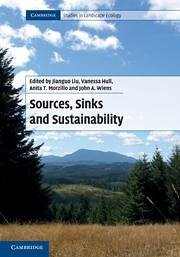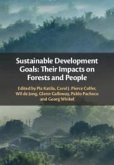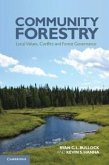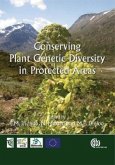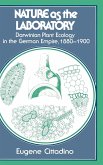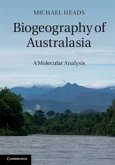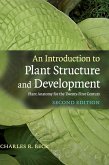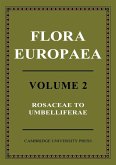Sources, Sinks and Sustainability
Herausgeber: Liu, Jianguo
Sources, Sinks and Sustainability
Herausgeber: Liu, Jianguo
- Gebundenes Buch
- Merkliste
- Auf die Merkliste
- Bewerten Bewerten
- Teilen
- Produkt teilen
- Produkterinnerung
- Produkterinnerung
Presents the latest advances in source-sink theory, methods and applications for sustaining natural resources and biodiversity.
Andere Kunden interessierten sich auch für
![Sustainable Development Goals Sustainable Development Goals]() Sustainable Development Goals126,99 €
Sustainable Development Goals126,99 €![Community Forestry Community Forestry]() Ryan C L BullockCommunity Forestry100,99 €
Ryan C L BullockCommunity Forestry100,99 €![Conserving Plant Genetic Diversity in Protected Areas Conserving Plant Genetic Diversity in Protected Areas]() Jose M IriondoConserving Plant Genetic Diversity in Protected Areas266,99 €
Jose M IriondoConserving Plant Genetic Diversity in Protected Areas266,99 €![Nature as the Laboratory Nature as the Laboratory]() Eugene CittadinoNature as the Laboratory109,99 €
Eugene CittadinoNature as the Laboratory109,99 €![Biogeography of Australasia Biogeography of Australasia]() Michael HeadsBiogeography of Australasia124,99 €
Michael HeadsBiogeography of Australasia124,99 €![An Introduction to Plant Structure and Development An Introduction to Plant Structure and Development]() Charles B. BeckAn Introduction to Plant Structure and Development72,99 €
Charles B. BeckAn Introduction to Plant Structure and Development72,99 €![Flora Europaea Flora Europaea]() Flora Europaea65,99 €
Flora Europaea65,99 €-
-
-
Presents the latest advances in source-sink theory, methods and applications for sustaining natural resources and biodiversity.
Hinweis: Dieser Artikel kann nur an eine deutsche Lieferadresse ausgeliefert werden.
Hinweis: Dieser Artikel kann nur an eine deutsche Lieferadresse ausgeliefert werden.
Produktdetails
- Produktdetails
- Verlag: Cambridge University Press
- Seitenzahl: 544
- Erscheinungstermin: 8. August 2011
- Englisch
- Abmessung: 249mm x 175mm x 28mm
- Gewicht: 1179g
- ISBN-13: 9780521199476
- ISBN-10: 0521199476
- Artikelnr.: 34558696
- Herstellerkennzeichnung
- Libri GmbH
- Europaallee 1
- 36244 Bad Hersfeld
- gpsr@libri.de
- Verlag: Cambridge University Press
- Seitenzahl: 544
- Erscheinungstermin: 8. August 2011
- Englisch
- Abmessung: 249mm x 175mm x 28mm
- Gewicht: 1179g
- ISBN-13: 9780521199476
- ISBN-10: 0521199476
- Artikelnr.: 34558696
- Herstellerkennzeichnung
- Libri GmbH
- Europaallee 1
- 36244 Bad Hersfeld
- gpsr@libri.de
Preface; Acknowledgements; List of contributors; Part I. Introduction: 1.
Impact of a classic paper by H. Ronald Pulliam: the first 20 years Vanessa
Hull, Anita T. Morzillo and Jianguo Liu; Part II. Advances in Source-Sink
Theory: 2. Evolution in source-sink environments: implications for niche
conservatism Robert D. Holt; 3. Source-sink dynamics emerging from unstable
ideal-free habitat selection Douglas W. Morris; 4. Sources and sinks in the
evolution and persistence of mutualisms Craig W. Benkman and Adam M.
Siepielski; 5. Effects of climate change on dynamics and stability of
multiregional populations Mark C. Andersen; 6. Habitat quality, niche
breadth, temporal stochasticity, and the persistence of populations in
heterogeneous landscapes Scott M. Pearson and Jennifer M. Fraterrigo; 7.
When sinks rescue sources in dynamic environments Matthew R. Falcy and
Brent J. Danielson; 8. Sinks, sustainability, and conservation incentives
Alessandro Gimona, Gary Polhill and Ben Davies; Part III. Progress in
Source-Sink Methodology: 9. On estimating demographic and dispersal
parameters for niche and source-sink models H. Ronald Pulliam, John M.
Drake and Juliet R. C. Pulliam; 10. Source-sink status of small and large
wetland fragments and growth rate of a population network Gilberto
Pasinelli, Jonathan P. Runge and Karin Schiegg; 11. Demographic and
dispersal data from anthropogenic grasslands: what should we measure? John
B. Dunning, Jr, Daniel M. Scheiman and Alexandra Houston; 12. Network
analysis: a tool for studying the connectivity of source-sink systems
Ferenc Jordán; 13. Sources, sinks, and model accuracy Matthew A. Etterson,
Brian J. Olsen, Russell Greenberg and W. Gregory Shriver; 14.
Scale-dependence of habitat sources and sinks Jeffrey M. Diez and Itamar
Giladi; 15. Effects of experimental population removal for the spatial
population ecology of the alpine butterfly, Parnassius smintheus Stephen F.
Matter and Jens Roland; Part IV. Improvement of Source-Sink Management: 16.
Contribution of source-sink theory to protected area science Andrew Hansen;
17. Evidence of source-sink dynamics in marine and estuarine species
Romuald N. Lipcius and Gina M. Ralph; 18. Population networks with sources
and sinks along productivity gradients in the Fiordland Marine Area, New
Zealand: a case study on the sea urchin Evechinus chloroticus Stephen R.
Wing; 19. Source-sinks, metapopulations, and forest reserves: conserving
northern flying squirrels in the temperate rainforests of Southeast Alaska
Winston P. Smith, David K. Person and Sanjay Pyare; 20. Does habitat
fragmentation generate breeding sources, sinks, and ecological traps in
migratory songbirds? Scott K. Robinson and Jeffrey P. Hoover; 21.
Source-sink population dynamics and sustainable leaf harvest of the
understory palm Chamaedorea radicalis Eric J. Berry, David L. Gorchov and
Bryan A. Endress; 22. Assessing positive and negative ecological effects of
corridors Nick Haddad, Brian Hudgens, Ellen I. Damschen, Douglas J. Levey,
John L. Orrock, Joshua J. Tewksbury and Aimee J. Weldon; Part V. Synthesis:
23. Sources and sinks: what is the reality? John Wiens and Beatrice Van
Horne; Index.
Impact of a classic paper by H. Ronald Pulliam: the first 20 years Vanessa
Hull, Anita T. Morzillo and Jianguo Liu; Part II. Advances in Source-Sink
Theory: 2. Evolution in source-sink environments: implications for niche
conservatism Robert D. Holt; 3. Source-sink dynamics emerging from unstable
ideal-free habitat selection Douglas W. Morris; 4. Sources and sinks in the
evolution and persistence of mutualisms Craig W. Benkman and Adam M.
Siepielski; 5. Effects of climate change on dynamics and stability of
multiregional populations Mark C. Andersen; 6. Habitat quality, niche
breadth, temporal stochasticity, and the persistence of populations in
heterogeneous landscapes Scott M. Pearson and Jennifer M. Fraterrigo; 7.
When sinks rescue sources in dynamic environments Matthew R. Falcy and
Brent J. Danielson; 8. Sinks, sustainability, and conservation incentives
Alessandro Gimona, Gary Polhill and Ben Davies; Part III. Progress in
Source-Sink Methodology: 9. On estimating demographic and dispersal
parameters for niche and source-sink models H. Ronald Pulliam, John M.
Drake and Juliet R. C. Pulliam; 10. Source-sink status of small and large
wetland fragments and growth rate of a population network Gilberto
Pasinelli, Jonathan P. Runge and Karin Schiegg; 11. Demographic and
dispersal data from anthropogenic grasslands: what should we measure? John
B. Dunning, Jr, Daniel M. Scheiman and Alexandra Houston; 12. Network
analysis: a tool for studying the connectivity of source-sink systems
Ferenc Jordán; 13. Sources, sinks, and model accuracy Matthew A. Etterson,
Brian J. Olsen, Russell Greenberg and W. Gregory Shriver; 14.
Scale-dependence of habitat sources and sinks Jeffrey M. Diez and Itamar
Giladi; 15. Effects of experimental population removal for the spatial
population ecology of the alpine butterfly, Parnassius smintheus Stephen F.
Matter and Jens Roland; Part IV. Improvement of Source-Sink Management: 16.
Contribution of source-sink theory to protected area science Andrew Hansen;
17. Evidence of source-sink dynamics in marine and estuarine species
Romuald N. Lipcius and Gina M. Ralph; 18. Population networks with sources
and sinks along productivity gradients in the Fiordland Marine Area, New
Zealand: a case study on the sea urchin Evechinus chloroticus Stephen R.
Wing; 19. Source-sinks, metapopulations, and forest reserves: conserving
northern flying squirrels in the temperate rainforests of Southeast Alaska
Winston P. Smith, David K. Person and Sanjay Pyare; 20. Does habitat
fragmentation generate breeding sources, sinks, and ecological traps in
migratory songbirds? Scott K. Robinson and Jeffrey P. Hoover; 21.
Source-sink population dynamics and sustainable leaf harvest of the
understory palm Chamaedorea radicalis Eric J. Berry, David L. Gorchov and
Bryan A. Endress; 22. Assessing positive and negative ecological effects of
corridors Nick Haddad, Brian Hudgens, Ellen I. Damschen, Douglas J. Levey,
John L. Orrock, Joshua J. Tewksbury and Aimee J. Weldon; Part V. Synthesis:
23. Sources and sinks: what is the reality? John Wiens and Beatrice Van
Horne; Index.
Preface; Acknowledgements; List of contributors; Part I. Introduction: 1.
Impact of a classic paper by H. Ronald Pulliam: the first 20 years Vanessa
Hull, Anita T. Morzillo and Jianguo Liu; Part II. Advances in Source-Sink
Theory: 2. Evolution in source-sink environments: implications for niche
conservatism Robert D. Holt; 3. Source-sink dynamics emerging from unstable
ideal-free habitat selection Douglas W. Morris; 4. Sources and sinks in the
evolution and persistence of mutualisms Craig W. Benkman and Adam M.
Siepielski; 5. Effects of climate change on dynamics and stability of
multiregional populations Mark C. Andersen; 6. Habitat quality, niche
breadth, temporal stochasticity, and the persistence of populations in
heterogeneous landscapes Scott M. Pearson and Jennifer M. Fraterrigo; 7.
When sinks rescue sources in dynamic environments Matthew R. Falcy and
Brent J. Danielson; 8. Sinks, sustainability, and conservation incentives
Alessandro Gimona, Gary Polhill and Ben Davies; Part III. Progress in
Source-Sink Methodology: 9. On estimating demographic and dispersal
parameters for niche and source-sink models H. Ronald Pulliam, John M.
Drake and Juliet R. C. Pulliam; 10. Source-sink status of small and large
wetland fragments and growth rate of a population network Gilberto
Pasinelli, Jonathan P. Runge and Karin Schiegg; 11. Demographic and
dispersal data from anthropogenic grasslands: what should we measure? John
B. Dunning, Jr, Daniel M. Scheiman and Alexandra Houston; 12. Network
analysis: a tool for studying the connectivity of source-sink systems
Ferenc Jordán; 13. Sources, sinks, and model accuracy Matthew A. Etterson,
Brian J. Olsen, Russell Greenberg and W. Gregory Shriver; 14.
Scale-dependence of habitat sources and sinks Jeffrey M. Diez and Itamar
Giladi; 15. Effects of experimental population removal for the spatial
population ecology of the alpine butterfly, Parnassius smintheus Stephen F.
Matter and Jens Roland; Part IV. Improvement of Source-Sink Management: 16.
Contribution of source-sink theory to protected area science Andrew Hansen;
17. Evidence of source-sink dynamics in marine and estuarine species
Romuald N. Lipcius and Gina M. Ralph; 18. Population networks with sources
and sinks along productivity gradients in the Fiordland Marine Area, New
Zealand: a case study on the sea urchin Evechinus chloroticus Stephen R.
Wing; 19. Source-sinks, metapopulations, and forest reserves: conserving
northern flying squirrels in the temperate rainforests of Southeast Alaska
Winston P. Smith, David K. Person and Sanjay Pyare; 20. Does habitat
fragmentation generate breeding sources, sinks, and ecological traps in
migratory songbirds? Scott K. Robinson and Jeffrey P. Hoover; 21.
Source-sink population dynamics and sustainable leaf harvest of the
understory palm Chamaedorea radicalis Eric J. Berry, David L. Gorchov and
Bryan A. Endress; 22. Assessing positive and negative ecological effects of
corridors Nick Haddad, Brian Hudgens, Ellen I. Damschen, Douglas J. Levey,
John L. Orrock, Joshua J. Tewksbury and Aimee J. Weldon; Part V. Synthesis:
23. Sources and sinks: what is the reality? John Wiens and Beatrice Van
Horne; Index.
Impact of a classic paper by H. Ronald Pulliam: the first 20 years Vanessa
Hull, Anita T. Morzillo and Jianguo Liu; Part II. Advances in Source-Sink
Theory: 2. Evolution in source-sink environments: implications for niche
conservatism Robert D. Holt; 3. Source-sink dynamics emerging from unstable
ideal-free habitat selection Douglas W. Morris; 4. Sources and sinks in the
evolution and persistence of mutualisms Craig W. Benkman and Adam M.
Siepielski; 5. Effects of climate change on dynamics and stability of
multiregional populations Mark C. Andersen; 6. Habitat quality, niche
breadth, temporal stochasticity, and the persistence of populations in
heterogeneous landscapes Scott M. Pearson and Jennifer M. Fraterrigo; 7.
When sinks rescue sources in dynamic environments Matthew R. Falcy and
Brent J. Danielson; 8. Sinks, sustainability, and conservation incentives
Alessandro Gimona, Gary Polhill and Ben Davies; Part III. Progress in
Source-Sink Methodology: 9. On estimating demographic and dispersal
parameters for niche and source-sink models H. Ronald Pulliam, John M.
Drake and Juliet R. C. Pulliam; 10. Source-sink status of small and large
wetland fragments and growth rate of a population network Gilberto
Pasinelli, Jonathan P. Runge and Karin Schiegg; 11. Demographic and
dispersal data from anthropogenic grasslands: what should we measure? John
B. Dunning, Jr, Daniel M. Scheiman and Alexandra Houston; 12. Network
analysis: a tool for studying the connectivity of source-sink systems
Ferenc Jordán; 13. Sources, sinks, and model accuracy Matthew A. Etterson,
Brian J. Olsen, Russell Greenberg and W. Gregory Shriver; 14.
Scale-dependence of habitat sources and sinks Jeffrey M. Diez and Itamar
Giladi; 15. Effects of experimental population removal for the spatial
population ecology of the alpine butterfly, Parnassius smintheus Stephen F.
Matter and Jens Roland; Part IV. Improvement of Source-Sink Management: 16.
Contribution of source-sink theory to protected area science Andrew Hansen;
17. Evidence of source-sink dynamics in marine and estuarine species
Romuald N. Lipcius and Gina M. Ralph; 18. Population networks with sources
and sinks along productivity gradients in the Fiordland Marine Area, New
Zealand: a case study on the sea urchin Evechinus chloroticus Stephen R.
Wing; 19. Source-sinks, metapopulations, and forest reserves: conserving
northern flying squirrels in the temperate rainforests of Southeast Alaska
Winston P. Smith, David K. Person and Sanjay Pyare; 20. Does habitat
fragmentation generate breeding sources, sinks, and ecological traps in
migratory songbirds? Scott K. Robinson and Jeffrey P. Hoover; 21.
Source-sink population dynamics and sustainable leaf harvest of the
understory palm Chamaedorea radicalis Eric J. Berry, David L. Gorchov and
Bryan A. Endress; 22. Assessing positive and negative ecological effects of
corridors Nick Haddad, Brian Hudgens, Ellen I. Damschen, Douglas J. Levey,
John L. Orrock, Joshua J. Tewksbury and Aimee J. Weldon; Part V. Synthesis:
23. Sources and sinks: what is the reality? John Wiens and Beatrice Van
Horne; Index.

